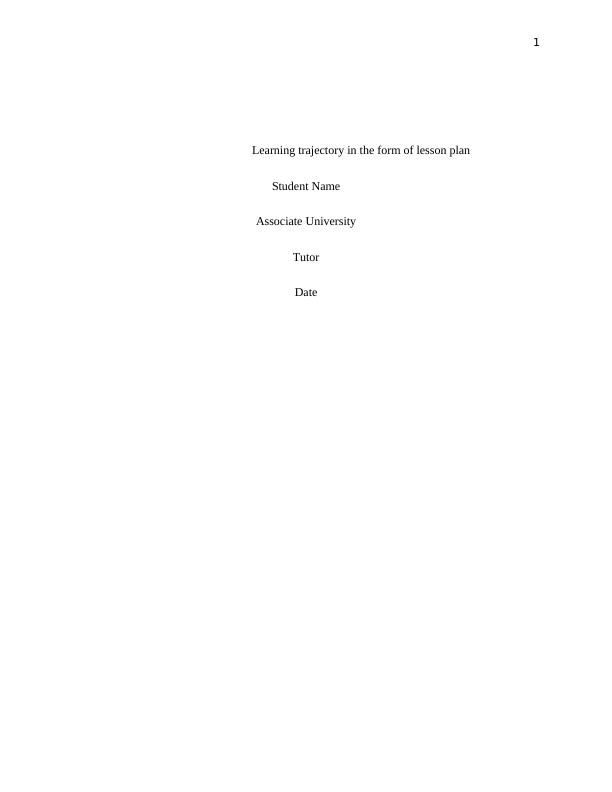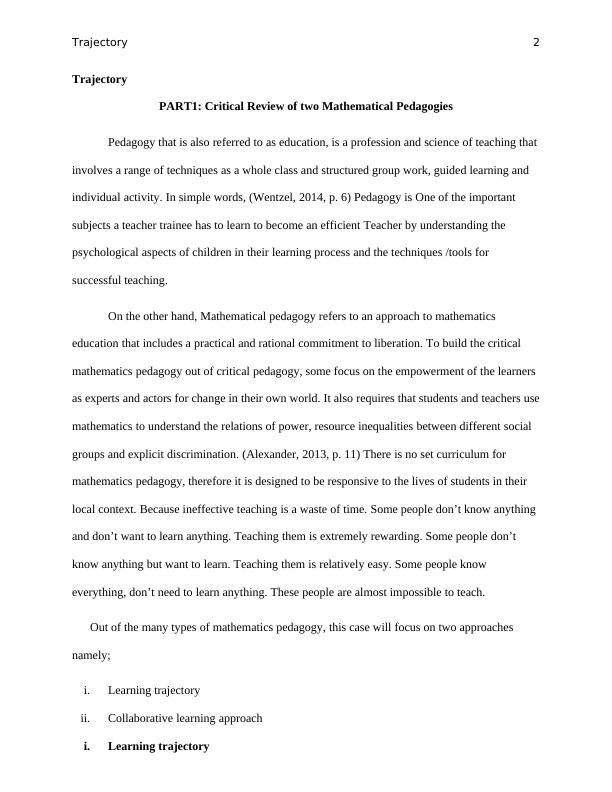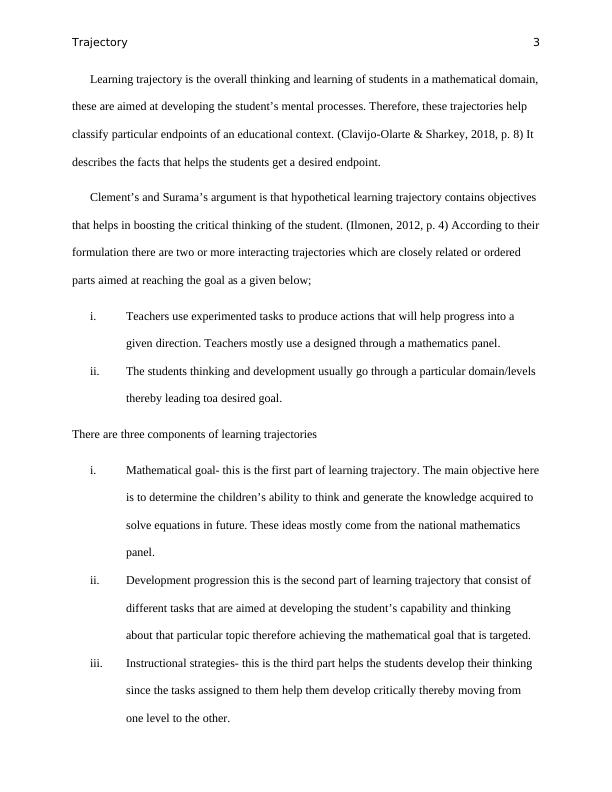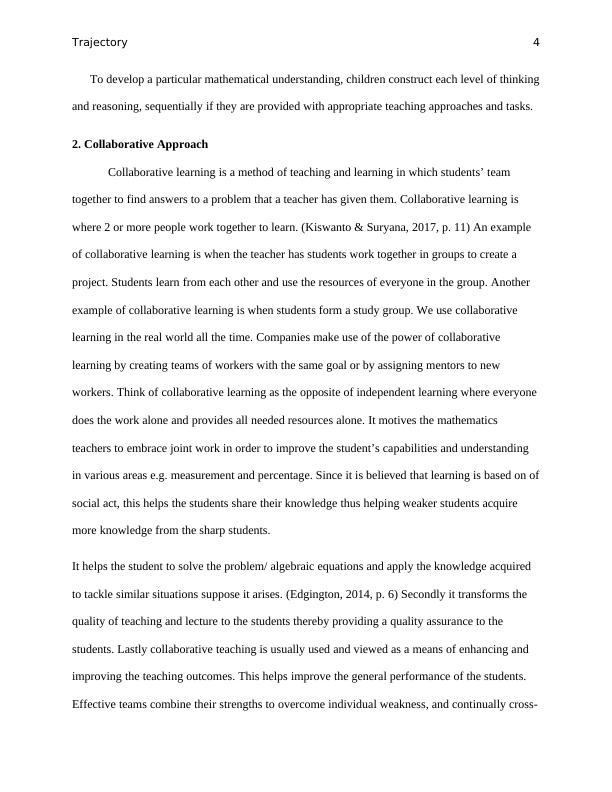Learning Trajectory in the Form of Lesson Plan
Added on 2022-08-21
14 Pages3503 Words14 Views
1
Learning trajectory in the form of lesson plan
Student Name
Associate University
Tutor
Date
Learning trajectory in the form of lesson plan
Student Name
Associate University
Tutor
Date

Trajectory 2
Trajectory
PART1: Critical Review of two Mathematical Pedagogies
Pedagogy that is also referred to as education, is a profession and science of teaching that
involves a range of techniques as a whole class and structured group work, guided learning and
individual activity. In simple words, (Wentzel, 2014, p. 6) Pedagogy is One of the important
subjects a teacher trainee has to learn to become an efficient Teacher by understanding the
psychological aspects of children in their learning process and the techniques /tools for
successful teaching.
On the other hand, Mathematical pedagogy refers to an approach to mathematics
education that includes a practical and rational commitment to liberation. To build the critical
mathematics pedagogy out of critical pedagogy, some focus on the empowerment of the learners
as experts and actors for change in their own world. It also requires that students and teachers use
mathematics to understand the relations of power, resource inequalities between different social
groups and explicit discrimination. (Alexander, 2013, p. 11) There is no set curriculum for
mathematics pedagogy, therefore it is designed to be responsive to the lives of students in their
local context. Because ineffective teaching is a waste of time. Some people don’t know anything
and don’t want to learn anything. Teaching them is extremely rewarding. Some people don’t
know anything but want to learn. Teaching them is relatively easy. Some people know
everything, don’t need to learn anything. These people are almost impossible to teach.
Out of the many types of mathematics pedagogy, this case will focus on two approaches
namely;
i. Learning trajectory
ii. Collaborative learning approach
i. Learning trajectory
Trajectory
PART1: Critical Review of two Mathematical Pedagogies
Pedagogy that is also referred to as education, is a profession and science of teaching that
involves a range of techniques as a whole class and structured group work, guided learning and
individual activity. In simple words, (Wentzel, 2014, p. 6) Pedagogy is One of the important
subjects a teacher trainee has to learn to become an efficient Teacher by understanding the
psychological aspects of children in their learning process and the techniques /tools for
successful teaching.
On the other hand, Mathematical pedagogy refers to an approach to mathematics
education that includes a practical and rational commitment to liberation. To build the critical
mathematics pedagogy out of critical pedagogy, some focus on the empowerment of the learners
as experts and actors for change in their own world. It also requires that students and teachers use
mathematics to understand the relations of power, resource inequalities between different social
groups and explicit discrimination. (Alexander, 2013, p. 11) There is no set curriculum for
mathematics pedagogy, therefore it is designed to be responsive to the lives of students in their
local context. Because ineffective teaching is a waste of time. Some people don’t know anything
and don’t want to learn anything. Teaching them is extremely rewarding. Some people don’t
know anything but want to learn. Teaching them is relatively easy. Some people know
everything, don’t need to learn anything. These people are almost impossible to teach.
Out of the many types of mathematics pedagogy, this case will focus on two approaches
namely;
i. Learning trajectory
ii. Collaborative learning approach
i. Learning trajectory

Trajectory 3
Learning trajectory is the overall thinking and learning of students in a mathematical domain,
these are aimed at developing the student’s mental processes. Therefore, these trajectories help
classify particular endpoints of an educational context. (Clavijo-Olarte & Sharkey, 2018, p. 8) It
describes the facts that helps the students get a desired endpoint.
Clement’s and Surama’s argument is that hypothetical learning trajectory contains objectives
that helps in boosting the critical thinking of the student. (Ilmonen, 2012, p. 4) According to their
formulation there are two or more interacting trajectories which are closely related or ordered
parts aimed at reaching the goal as a given below;
i. Teachers use experimented tasks to produce actions that will help progress into a
given direction. Teachers mostly use a designed through a mathematics panel.
ii. The students thinking and development usually go through a particular domain/levels
thereby leading toa desired goal.
There are three components of learning trajectories
i. Mathematical goal- this is the first part of learning trajectory. The main objective here
is to determine the children’s ability to think and generate the knowledge acquired to
solve equations in future. These ideas mostly come from the national mathematics
panel.
ii. Development progression this is the second part of learning trajectory that consist of
different tasks that are aimed at developing the student’s capability and thinking
about that particular topic therefore achieving the mathematical goal that is targeted.
iii. Instructional strategies- this is the third part helps the students develop their thinking
since the tasks assigned to them help them develop critically thereby moving from
one level to the other.
Learning trajectory is the overall thinking and learning of students in a mathematical domain,
these are aimed at developing the student’s mental processes. Therefore, these trajectories help
classify particular endpoints of an educational context. (Clavijo-Olarte & Sharkey, 2018, p. 8) It
describes the facts that helps the students get a desired endpoint.
Clement’s and Surama’s argument is that hypothetical learning trajectory contains objectives
that helps in boosting the critical thinking of the student. (Ilmonen, 2012, p. 4) According to their
formulation there are two or more interacting trajectories which are closely related or ordered
parts aimed at reaching the goal as a given below;
i. Teachers use experimented tasks to produce actions that will help progress into a
given direction. Teachers mostly use a designed through a mathematics panel.
ii. The students thinking and development usually go through a particular domain/levels
thereby leading toa desired goal.
There are three components of learning trajectories
i. Mathematical goal- this is the first part of learning trajectory. The main objective here
is to determine the children’s ability to think and generate the knowledge acquired to
solve equations in future. These ideas mostly come from the national mathematics
panel.
ii. Development progression this is the second part of learning trajectory that consist of
different tasks that are aimed at developing the student’s capability and thinking
about that particular topic therefore achieving the mathematical goal that is targeted.
iii. Instructional strategies- this is the third part helps the students develop their thinking
since the tasks assigned to them help them develop critically thereby moving from
one level to the other.

Trajectory 4
To develop a particular mathematical understanding, children construct each level of thinking
and reasoning, sequentially if they are provided with appropriate teaching approaches and tasks.
2. Collaborative Approach
Collaborative learning is a method of teaching and learning in which students’ team
together to find answers to a problem that a teacher has given them. Collaborative learning is
where 2 or more people work together to learn. (Kiswanto & Suryana, 2017, p. 11) An example
of collaborative learning is when the teacher has students work together in groups to create a
project. Students learn from each other and use the resources of everyone in the group. Another
example of collaborative learning is when students form a study group. We use collaborative
learning in the real world all the time. Companies make use of the power of collaborative
learning by creating teams of workers with the same goal or by assigning mentors to new
workers. Think of collaborative learning as the opposite of independent learning where everyone
does the work alone and provides all needed resources alone. It motives the mathematics
teachers to embrace joint work in order to improve the student’s capabilities and understanding
in various areas e.g. measurement and percentage. Since it is believed that learning is based on of
social act, this helps the students share their knowledge thus helping weaker students acquire
more knowledge from the sharp students.
It helps the student to solve the problem/ algebraic equations and apply the knowledge acquired
to tackle similar situations suppose it arises. (Edgington, 2014, p. 6) Secondly it transforms the
quality of teaching and lecture to the students thereby providing a quality assurance to the
students. Lastly collaborative teaching is usually used and viewed as a means of enhancing and
improving the teaching outcomes. This helps improve the general performance of the students.
Effective teams combine their strengths to overcome individual weakness, and continually cross-
To develop a particular mathematical understanding, children construct each level of thinking
and reasoning, sequentially if they are provided with appropriate teaching approaches and tasks.
2. Collaborative Approach
Collaborative learning is a method of teaching and learning in which students’ team
together to find answers to a problem that a teacher has given them. Collaborative learning is
where 2 or more people work together to learn. (Kiswanto & Suryana, 2017, p. 11) An example
of collaborative learning is when the teacher has students work together in groups to create a
project. Students learn from each other and use the resources of everyone in the group. Another
example of collaborative learning is when students form a study group. We use collaborative
learning in the real world all the time. Companies make use of the power of collaborative
learning by creating teams of workers with the same goal or by assigning mentors to new
workers. Think of collaborative learning as the opposite of independent learning where everyone
does the work alone and provides all needed resources alone. It motives the mathematics
teachers to embrace joint work in order to improve the student’s capabilities and understanding
in various areas e.g. measurement and percentage. Since it is believed that learning is based on of
social act, this helps the students share their knowledge thus helping weaker students acquire
more knowledge from the sharp students.
It helps the student to solve the problem/ algebraic equations and apply the knowledge acquired
to tackle similar situations suppose it arises. (Edgington, 2014, p. 6) Secondly it transforms the
quality of teaching and lecture to the students thereby providing a quality assurance to the
students. Lastly collaborative teaching is usually used and viewed as a means of enhancing and
improving the teaching outcomes. This helps improve the general performance of the students.
Effective teams combine their strengths to overcome individual weakness, and continually cross-

End of preview
Want to access all the pages? Upload your documents or become a member.
Related Documents
Pedagogical Practices in Early Years Nursery Settinglg...
|10
|3630
|41
Creative and Media Arts Pedagogies in Early Childhood Educationlg...
|8
|2604
|400
European Journal of Psychology of Educationlg...
|8
|1848
|192
Traditional Teaching Method Assignmentlg...
|12
|2617
|464
Report about Learning Pedagogy Australia 2022lg...
|11
|2294
|15
Mathematics for Young Children (Doc)lg...
|17
|4930
|51
